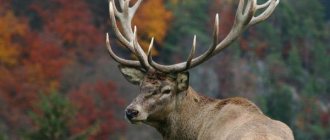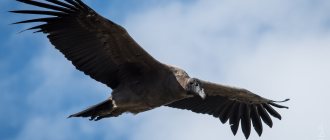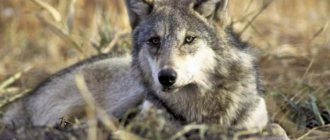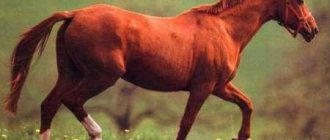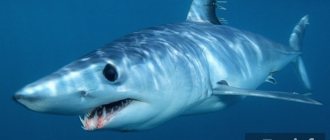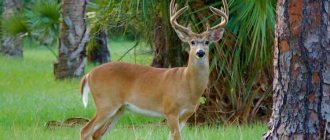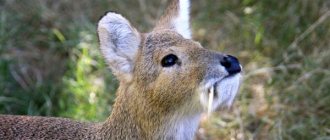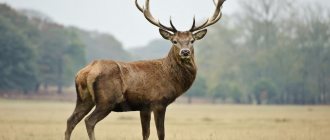“Crowned” with impressive antlers, with a graceful and at the same time powerful body, red deer (Cervus elaphus), known for their trumpeting voice during the rut, are popular heraldic symbols and a favorite hunting trophy of the “old” and “new” aristocracy of the planet. But the many times greater greatness of the extinct relative of the red deer, discovered at the end of the 18th century in the Irish swamps, prompted the British authorities to depict the ideal heraldic deer on the coat of arms of Northern Ireland.
Introduced in 1924, the Northern Irish coat of arms, designed by the Ulster herald Neville Wilkinson, showcased the greatness of Northern Ireland in the Irish elk that once inhabited the land. Today this coat of arms is not official, as well as the “Irish-moose” definition of the species of giant deer
What was the largest deer from the deer family (Cervidae), where and when did it live, how did it get such huge antlers and why did it become extinct - the questions discussed in this article.
Description of the animal
Bighorn (giant, broad-horned) deer is also called megaloceros or Irish elk. This extinct animal is similar in appearance to a fallow deer, but much larger.
What did he look like?
The creature was distinguished by its large stature, huge horns that expanded upward in the form of a shovel with shoots. Judging by the structure of the teeth and paws, the deer lived in areas with wet vegetation. The height at the shoulders was 2.2 m. The weight of the animal varied between 450-700 kg. For comparison: an adult moose weighs 350-600 kg.
Like modern artiodactyls, the creature shed its horns and grew new ones in the spring. Scientists suggest that the growths on the head increased with each generation as a result of natural selection. As a result, they became so huge that the males could no longer lead their usual lifestyle and died out.
The horns reached 4 m in length. They weighed about 50 kg.
Character and lifestyle
The horned inhabitants of the forest lived in small herds, each of which could inhabit up to 400 hectares of territory. With the onset of autumn, harems were formed.
Depending on the season, mammals migrated, covering distances of 100-150 km. The animals wintered in areas with little snow. During the summer heat, deer stayed closer to bodies of water and climbed into rivers and lakes to cool off.
What did you eat?
The Irish elk fed exclusively on vegetation. His diet included:
- kidneys;
- leaves;
- shoots;
- shrubs;
- berries;
- mushrooms;
- mosses;
- fruits of plants.
The animals feasted on seaweed, which was thrown onto the shore by waves, and branches of deciduous trees. If there was not enough food, the deer ate shoots of coniferous trees.
Where did he live?
Our contemporaries have never seen artiodactyls. Populations existed in the last two geological eras. The specific time of discovery of the animal is not known. It is generally accepted that the big-horned deer appeared 800 thousand years ago.
The distribution of ancient mammals in European and Asian countries and North Africa is known. Many skeletons were found in Ireland, Crimea, Kazakhstan, the North Caucasus, and the Ryazan and Sverdlovsk regions.
The last remains date back to approximately 7.7 thousand years old.
In dense forests, an elk simply could not live with such large antlers. Because of them, individuals often got stuck in thickets and became victims of people and predators. The narrowing of the range is associated with an increase in the number of people. The final blow could be the human hunt for mammals.
Reproduction
According to scientists, the reproduction of giant deer was not much different from the reproduction of artiodactyl offspring in our time. At 2-3 years old, the males were already ready to fertilize the female. The mother carried the cubs for 190-265 days. Usually one fawn was born, rarely twins.
About 4 weeks after birth, the baby could feed on his own, but continued to drink his mother's milk. The cubs developed quite quickly. Their growth slowed down significantly after 6 months.
Natural enemies
The animals' enemies were wolves who hunted in packs. Herbivores defended themselves from them with powerful hooves and horns. Depending on the habitat, the individuals were hunted by tigers, lynxes, and bears. Frail cubs and sick old artiodactyls were easy prey.
The Irish elk is a rather passive creature. When an enemy attacked him, he quickly ran away. Animals could jump over obstacles as high as a whole wall. Females are much faster than males.
Changing of the climate
Adrian Lister, a paleobiologist at the Natural History Museum in London, has spent more than 25 years of his career studying Megaloceros. “They are one of the most famous extinct animals, along with the tyrannosaurus rex and the mammoth, but relatively little was known about them, and much of what we thought we knew turned out to be wrong,” he says.
Lister's mapping, dating and pollen studies showed that these animals were affected by climate change, experiencing the effects of the Recent Dryas, a period of sudden cooling that occurred approximately 13,000-12,000 years ago. To survive and thrive, these animals needed abundant, mineral-rich grass, leaves, and shoots. However, under the influence of cold, this vegetation gradually became scarce.
“It probably became more and more difficult for the males to grow antlers every year,” explains the researcher. "But the effects of cold weather on the females were likely the deciding factor."
At the same time, the researcher notes that perhaps Paleolithic people finished off the last of the already doomed populations. However, this has never been proven.
From then on, people forgot about the giant deer until the late 1500s and early 1600s, when Irish farmers, digging bogs to burn peat for fuel, began finding many of their fossilized antlers. Some of them still adorn the walls of castles and other buildings throughout the country.
In which museums can you see
An impressive collection of animal skeletons is located in Dublin at the Natural History Museum. You can see big-horned deer in the Starina Sibirskaya Nature Reserve. The ancient exhibit was found on the banks of a river in the Omsk region.
In 1886, the museum of the Ural Society of Natural History Enthusiasts received the remains of an Irish elk, which today are considered the pride of the collection. A separate holiday was even dedicated to the 130th anniversary of the discovery.
The skeleton of the animal can be seen in the Sverdlovsk Regional Museum of Local History in Yekaterinburg. The remains were restored: the missing legs were cast, the ribs were extended, and the vertebrae and shoulder blades were made from plaster. Photos of the skeleton were printed on postcards.
What was the big-horned giant like?
This deer bore antlers that were structurally similar to those of modern elk and reindeer, i.e. discarded after the next mating season and grown again by August (the beginning of the rut). Adult males of Megaloceros giganteus were the largest deer in Earth's history.
Physically, the giant deer was in many ways similar to the modern red deer, only much more powerful and larger. The heavy horns of the giant required special strengthening of the cervical spine, otherwise it would have been impossible to hold them
The body height of the giant deer at the withers (at the beginning of the neck in the upper part of the back) was about 2.1 meters. Adult males weighed over 680 kg. For comparison:
- Chukchi moose (Alces alces buturlini), the largest species of the moose genus, grows up to 2.15 m at the withers and reaches a weight of more than 700 kg (males);
- the common red deer (Cervus elaphus hippelaphus), the largest species of the deer family, reaches 1.3 m in height at the withers and weighs up to 170 kg (males);
- The caribou reindeer (Rangifer tarandus), the only modern species of the reindeer genus, reaches a height of 1.41 m at the withers and a maximum weight of 194 kg (males).
Standing out for its size and body weight, the giant deer is especially surprising in the width of its antlers. Megaloceros giganteus had the largest antlers of any living or extinct member of the deer family - over 3.65 m from left to right and weighing over 40 kg, almost twice the size of an adult moose (1.99 m)!
The obvious reason for the development of such large antlers was the consistent interest in them of female big-horned deer, who chose not only the largest, but also the most antlered males for procreation. Subsequently, it was sexual selection for antler size that became one of the reasons for the complete extinction of the giant deer species.
Big-horned deer in the Red Book
The big-horned deer is already an extinct animal. Individuals have long disappeared from the face of the Earth. Only rare species are included in the Red Book, that is, those animals that have not yet become extinct.
Main causes of extinction
The extinction of broad-horned deer is part of a process that has affected other species as well. Scientists believe that the reason for the disappearance was the lack of forest areas for habitat and reproduction of individuals.
Climate change turned out to be a serious factor. Global warming has left many creatures no chance to survive. Humans, environmental degradation and infectious diseases could have played a significant role in the extinction of the species.
Is there potential for a revival of the species?
There is too little information about the possible revival of the species. Perhaps in the future scientists will be able to recreate big-horned deer, because genetic engineering and biotechnology have made a serious breakthrough over the past 20 years.
The ancient elk is listed in the Black Book. It includes individuals that became extinct during human existence.
With the cloning of animals - dogs, cats, sheep, scientists took on extinct individuals. Forest giants can be recreated using a genetically modified deer or elk, or using conventional cloning. The revived creature will have key characteristics of the extinct creature.
Giant megaloceras: origin
Archaeological research shows that Megaloceros giganteus lived in Northern Europe and Northern Asia (lived in almost all of Eurasia: from Ireland to Lake Baikal), as well as on the northern outskirts of Africa. Most of the fossil remains of the animal were found in the swamps of what is now Ireland, hence its second name - Irish elk. Let us add that the term “moose” was assigned to it due to the external similarity of the horns. Several skeletons of this giant were discovered in our country (Crimea, North Caucasus, Sverdlovsk and Ryazan regions).
These prehistoric animals lived at the end of the Pleistocene and at the beginning of the Holocene, that is, in the period from 400 thousand to 7700 years ago. Megaloceros giganteus probably belonged to the so-called megafauna of the Pleistocene and early Holocene. Next to him lived, in particular, saber-toothed tigers, bears and cave lions, smilodon, as well as mammoths and hairy rhinoceroses, which together with him formed the group of the largest herbivores of that period.
Interesting facts about the animal
- There is an assumption that the animal’s large horns were the result of cruel selection in the natural environment. Males constantly used the outgrowths in fights with other males.
- Today, deer hunting is prohibited in many countries. Artiodactyls are under legislative protection.
- Large individuals were hunted alone. The tribesmen only helped to move and cut up the carcass.
- The most comfortable life for the Irish elk was the glaciation period of the late Pleistocene. It lasted over 114 thousand years.
- The skeleton of the animal was found in the Ryazan region in a peat bog. It is mentioned in Paustovsky’s work “The Meshcherskaya Side”, which was included in the school curriculum. Another find was discovered in the Sverdlovsk region. The deer bones were sold to a society of naturalists for 500 rubles - a large sum of money at that time.
Closest relatives
Because of its spade-shaped antlers, this extinct species of giant deer was considered from the beginning to be a close relative of elk and modern fallow deer. Later morphological and molecular studies proved its relationship with the modern Canadian deer (Latin Cervus elaphus canadensis) and red deer (Latin Cervus elaphus). Only recent genetic studies have definitively confirmed that the closest relative of Megaloceros giganteus is, in fact, the European fallow deer.
Antlers of a giant deer
The impressive antlers of the giant deer spanned about three meters. The largest antlers of this deer, found during archaeological excavations, reached 3.65 m and weighed almost 40 kg! This fact is so unusual and unique that even several different theories of their evolution have appeared. Some scientists are of the opinion that such horns in an animal are the result of strict natural selection. Males actively used the formations on their heads in the fight for the attention of females. Thus, only the largest and strongest individuals survived and gave birth to offspring.
Another theory is that the Irish deer became extinct because of its antlers. At a certain point, they reached very bulky sizes and began to interfere with the usual way of life. Scientists say the reason for the extinction of the species is the encroachment of forests on the open spaces where it probably lived. The horns interfered with the animal while passing through dense thickets and forests, because of this it often got stuck and could not get out. The deer became easy prey for predators, who eventually exterminated them.
